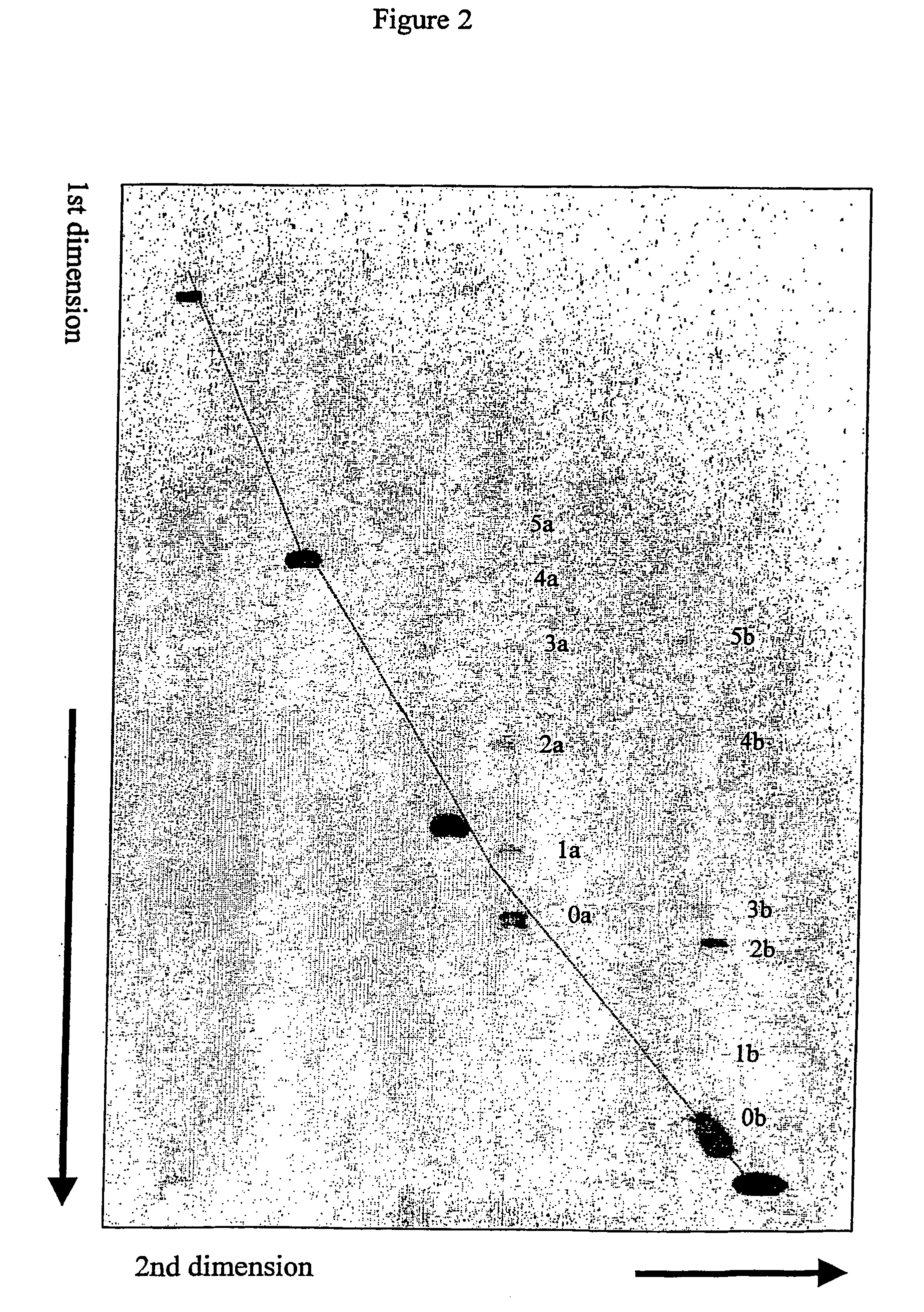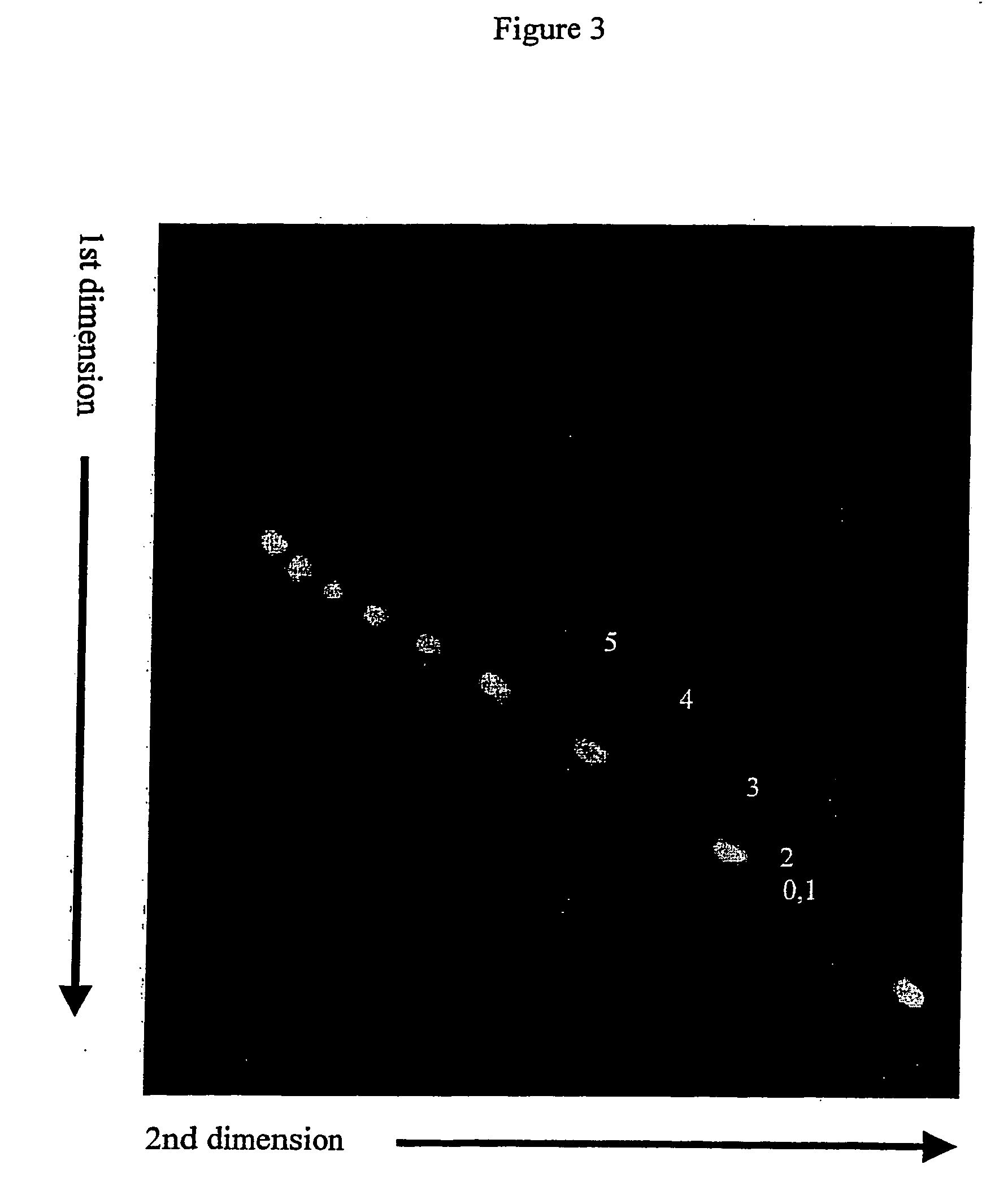Method for two-dimensional conformation-dependent separation of non-circular nucleic acids
a two-dimensional conformation-dependent separation and non-circular nucleic acid technology, applied in the field of nucleic acid analysis, can solve the problems of limited use of previously described methods for conformation-dependent separation of linear dna fragments, such as ha and csge, and significant conformational changes of the entire molecul
- Summary
- Abstract
- Description
- Claims
- Application Information
AI Technical Summary
Benefits of technology
Problems solved by technology
Method used
Image
Examples
example 1
Separation and Detection of Cy5 Labeled Linear DNA Fragments Containing Cytosine Bulges from Perfectly Matched Linear DNA Fragments Using Intercalator Approach.
[0068] Five diffrent 298 bp linear DNA fragments were prepared. Each fragment contained one defined cytosine bulge at its center with the bulge size ranging from 1 to 5 cytosines. Otherwise the DNA fragments were identical to each other. A perfectly matched 298 bp linear DNA fragment was also prepared. Execpt for not having a cytosine bulge this fragment had identical base sequence compared to the bulged DNA fragments. These 298 bp linear DNA fragments were prepared using three shorter DNA fragments. Two fragments were PCR amplified from the plasmid pBR322. One fragment (127 bp) was 5′ end-labeled with Cy5 fluorescent molecule and contained 3′ asymmetric overhang after digestion with Ava I. The other (132 bp) contained 5′ asymmetric overhang after digestion with Ban II. One fragment (31 bp) was synthesized as two oligonucle...
example 2
Separation and Detection of Linear DNA Fragments Containing Cytosine Bulges at their Center or Near One End of the Fragment from Perfectly Matched DNA Fragments Using Intercalator Approach.
[0073] Unlabeled linear DNA fragments containing defined cytosine bulges were prepared as described in Example 1. Instead of doing equimolar ligation, ligation with excess of one end fragment was done resulting in formation of two major ligation products. One was the 298 bp product with the bulge at the center as described in Example 1. The other was a 158 bp product formed by ligation between the 31 bp synthetic molecule containing the bulge molecule and the 127 bp PCR fragment. This fragment has the bulge 15 bp from its end.
[0074] Five perfectly matched DNA fragments (155 bp, 357 bp, 543 bp, 857 bp and 1395 bp) containing 5′ Cy5 label were also prepared using PCR amplification from the plasmid pBR322.
[0075] A mixture of the fragments described above was separated by 2-D CDE gel electrophores...
example 3
Separation and Detection of Cy5-Labeled Linear DNA Fragments Containing Cytosine Bulges from Perfectly Matched Fluorescein Labeled DNA Fragments in 7×8 cm Gel Format Using Intercalator Approach.
[0078] Linear Cy5-labeled DNA fragments containing cytosine bulges were prepared as described in Example 1. These DNA fragments were combined with 100 bp fluorescein ladder (BioRAD) containing 100, 200, 300, 400, 500, 600, 700, 800, 900 and 1000 bp DNA fragments. This DNA mixture was then separated by 2-D gel electrophoresis using 6% polyacrylamide gel. The gel was polymerized in 1×TBE buffer (89 mM Tris base, 89 mM borate, and 2 mM EDTA) for 1 hour. The first dimension gel electrophoresis was done in BioRad Mini Protean II vertical electrophoresis system using 7×8 cm glass sandwich with 1 mm spacers. The gel was run at room temperature for 90 minutes at 20 mA with 1×TBE in both upper and lower buffer chambers. The gel was removed from the glass sandwich and soaked in 100 ml of 1×TBE buffer...
PUM
| Property | Measurement | Unit |
|---|---|---|
| temperature | aaaaa | aaaaa |
| temperature | aaaaa | aaaaa |
| angles | aaaaa | aaaaa |
Abstract
Description
Claims
Application Information
 Login to View More
Login to View More - R&D
- Intellectual Property
- Life Sciences
- Materials
- Tech Scout
- Unparalleled Data Quality
- Higher Quality Content
- 60% Fewer Hallucinations
Browse by: Latest US Patents, China's latest patents, Technical Efficacy Thesaurus, Application Domain, Technology Topic, Popular Technical Reports.
© 2025 PatSnap. All rights reserved.Legal|Privacy policy|Modern Slavery Act Transparency Statement|Sitemap|About US| Contact US: help@patsnap.com



